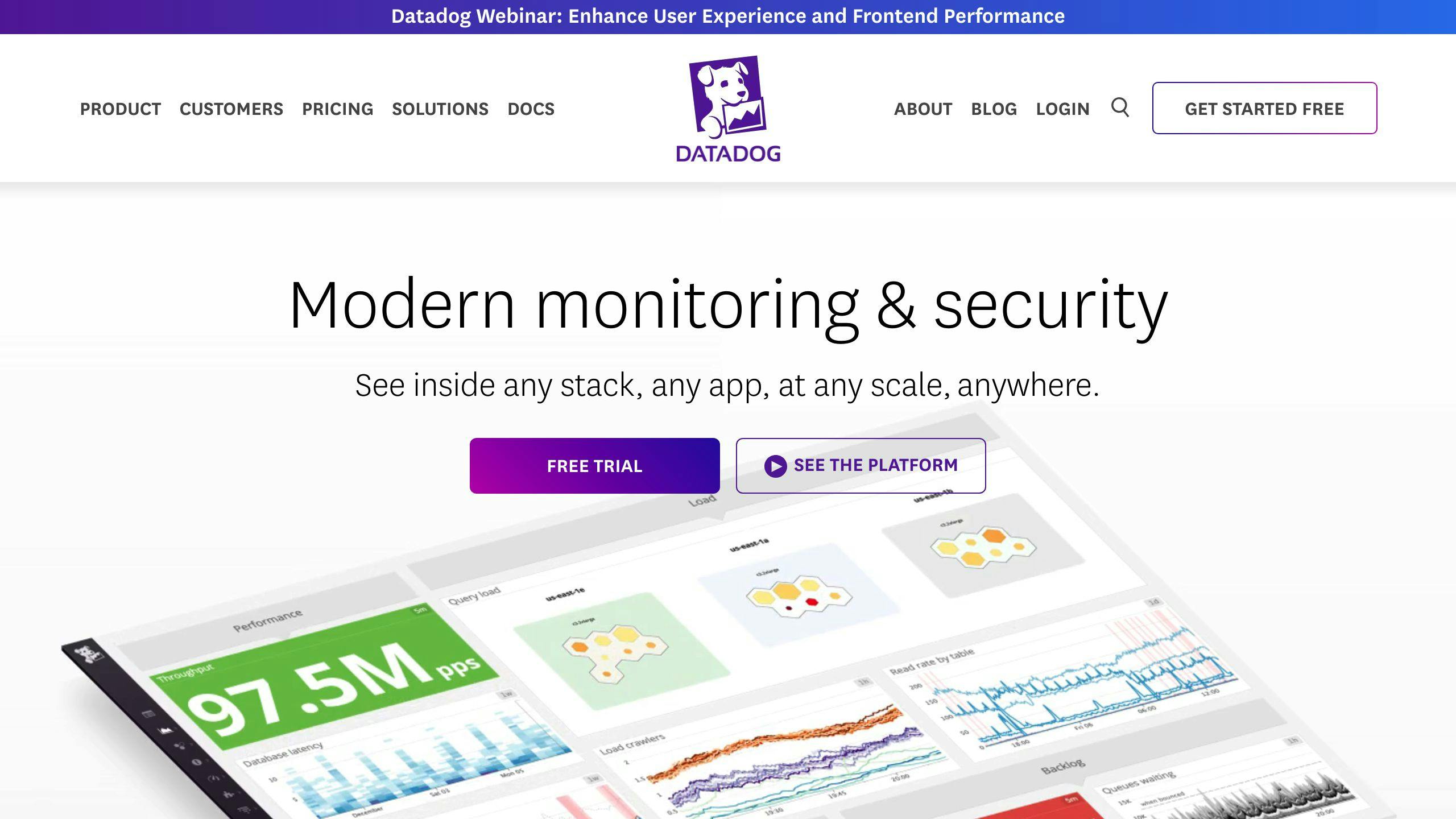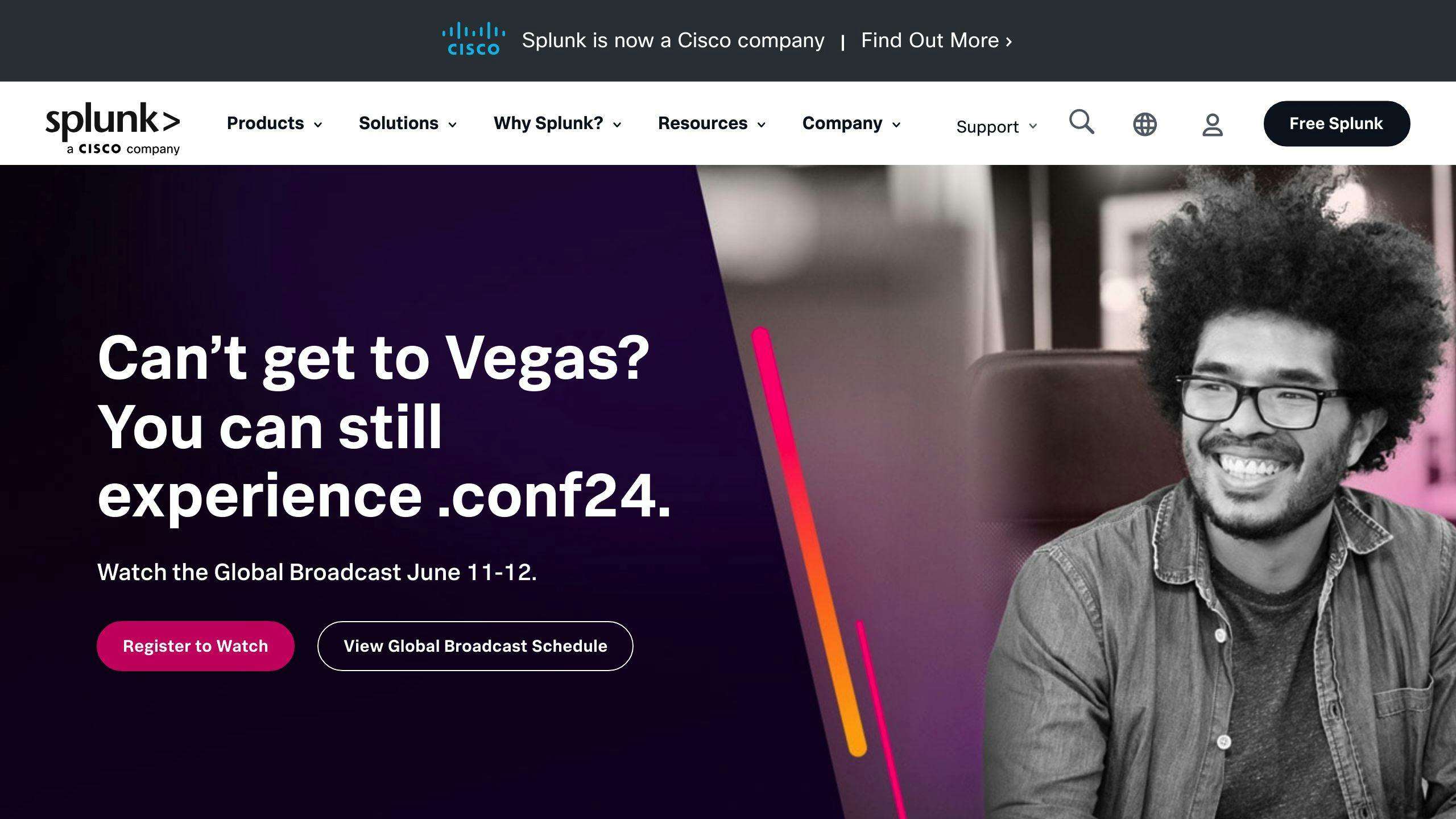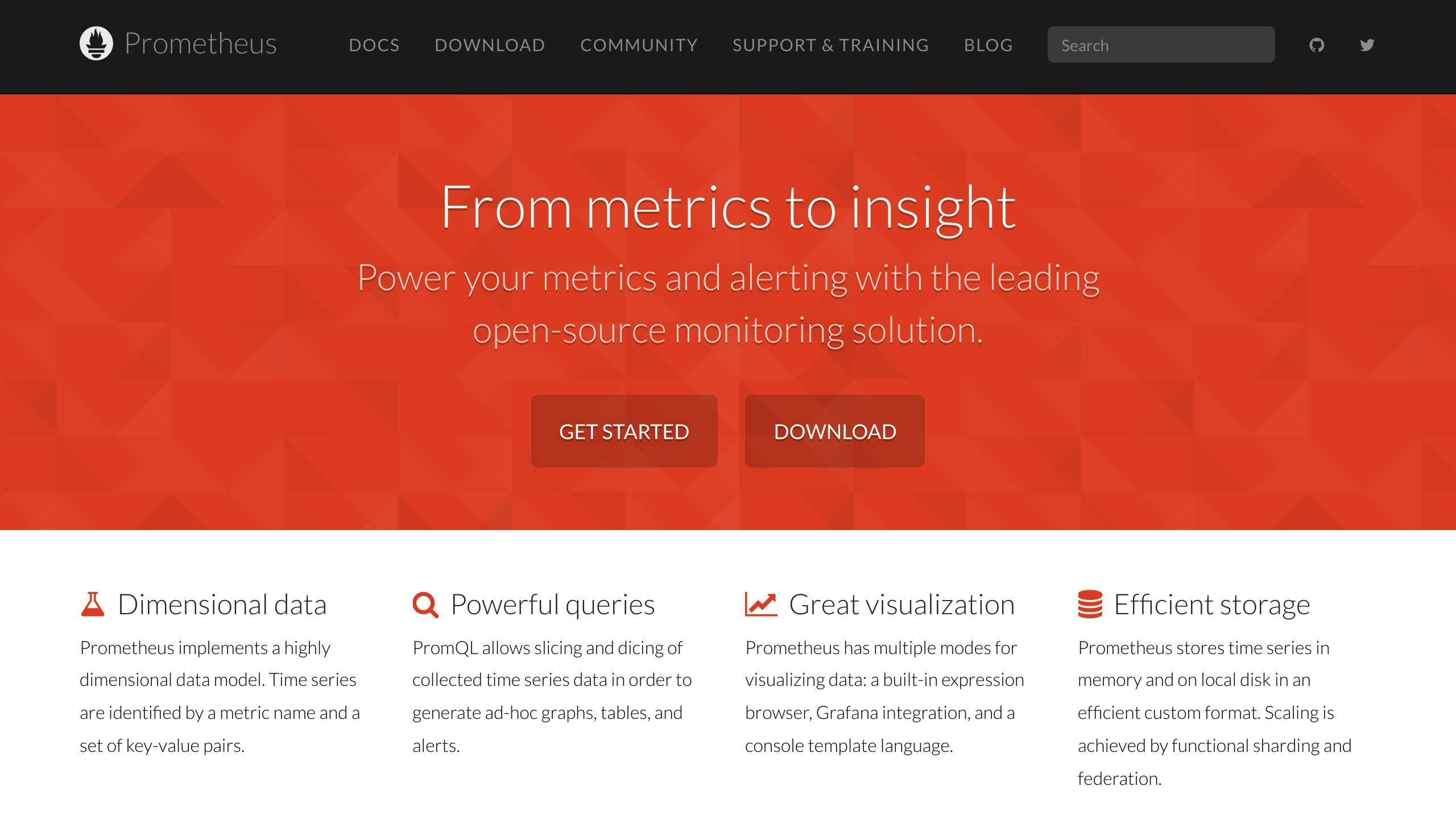Looking to scale your observability beyond Datadog? Here's a rundown of top alternatives:
- New Relic: Strong APM, free tier
- Splunk: Advanced search, flexible deployment
- Dynatrace: Full-stack monitoring, AI-powered
- Prometheus: Open-source, metrics-focused
- OpenTelemetry: Vendor-neutral data collection
Quick comparison:
| Tool | Key Strength | Pricing | Best For |
|---|---|---|---|
| Datadog | Cloud security | Complex, no free tier | Large enterprises |
| New Relic | APM capabilities | $0.30/GB after free 100GB | Small to medium businesses |
| Splunk | Data analytics | Volume-based | Big data environments |
| Dynatrace | AI-driven insights | Starts at $0.08/hour/host | Complex, large-scale systems |
| Prometheus | Cost-effective | Free, open-source | Cloud-native setups |
| OpenTelemetry | Flexibility | Free, open-source | Custom observability stacks |
When choosing, consider your data types, scalability needs, real-time requirements, existing tool integrations, and budget.
The trend is moving towards integrated platforms for a complete view of system health, crucial for complex IT infrastructures.
Related video from YouTube
1. Datadog

Datadog is a cloud monitoring platform for tracking applications and infrastructure across environments. It's known for wide-ranging features and integrations, but also complex pricing.
Key Features
- Infrastructure Monitoring
- Application Performance Monitoring (APM)
- Log Management
- Real User Monitoring (RUM)
- Synthetic Monitoring
- Network Performance Monitoring
Datadog provides a unified view of an organization's tech stack. Braze, a customer engagement platform, uses Datadog to standardize monitoring across teams.
"Datadog has enabled us to rally around one platform that will help us scale over the near and long-term." - Jamie Doheny, Chief of Staff, Braze
Scalability
Datadog's cloud-native architecture auto-scales to handle data spikes, suiting organizations of various sizes.
Pricing
Datadog's pricing is often cited as a pain point:
| Service | Starting Price |
|---|---|
| Infrastructure Monitoring | $15 per host/month (Pro) |
| APM | $31 per host/month |
| Log Management | $0.10 per GB/month |
| RUM | $1.50 per 1,000 sessions/month |
| Synthetic Monitoring | $5 per 10,000 API test runs/month |
Custom metrics ($0.05 each) can lead to unexpected costs, accounting for up to 52% of total bills.
Integrations
Datadog boasts over 500 integrations, surpassing competitors like Splunk (250 technologies).
While powerful, Datadog's complex pricing and potential high costs have led many to seek alternatives.
2. New Relic

New Relic is a cloud-based observability platform offering end-to-end visibility into complex software environments. It's a strong Datadog competitor, preferred by some for application monitoring.
Key Features
- Application Performance Monitoring (APM)
- Infrastructure Monitoring
- Log Management
- Real User Monitoring
- Synthetic Monitoring
- AIOps capabilities
New Relic processes 3 billion data points per minute, tracking metrics, events, logs, and traces.
Scalability
New Relic's cloud-native architecture handles large data volumes, suiting businesses of all sizes. It processes billions of data points per minute for real-time insights.
Pricing
New Relic's pricing is based on data usage and user types:
| Plan | Price | Features |
|---|---|---|
| Free Tier | $0 | 100GB data, unlimited users, basic alerts |
| Standard | Free for 1 user, 100GB/month | One full platform user |
| Core Users | $49/user/month | Additional users |
| Pro | Custom pricing | Unlimited users, advanced features |
Data ingestion costs $0.30 per GB above the free 100GB.
Integrations and Ease of Use
New Relic offers easy integration with an automated installation script. This simplicity gives it an edge for some users.
"New Relic is now my No. 1 tool for incident management, both in how it helps manage every service, and creates the notification channels. Fine-tuning alerts minimizes mean time to detect from five to under two minutes." - Lior Avni, Global Incident Manager, Gett.
AI-Powered Insights
New Relic's Applied Intelligence uses AI for anomaly detection, root cause analysis, and automation. CarParts.com found this valuable:
"New Relic Applied Intelligence was fast and easy to implement, enabling us to quickly bubble up issues from across the stack to allow us to take a targeted approach to determine what needs to be optimized or fixed, and how many human hours will be required." - Eugene Kovshilovsky, SVP of software engineering at CarParts.com, Inc.
New Relic's strength in application monitoring and user-friendly interface make it a top choice for many organizations scaling observability capabilities.
3. Splunk

Splunk is a powerful platform for searching, monitoring, and analyzing machine-generated big data. It offers on-premises (Splunk Enterprise) and cloud-based (Splunk Cloud) solutions.
Key Features
- Comprehensive data ingestion and analysis
- Real-time monitoring and alerting
- Advanced search capabilities
- AI-powered insights and automation
- Security and compliance features
Scalability
Splunk Enterprise scales based on your infrastructure, while Splunk Cloud offers automatic scaling.
Pricing
Splunk's pricing is based on data ingestion and computing capacity:
| Metric | Price |
|---|---|
| Data ingestion | Based on GB/day |
| Computing capacity | Measured in Splunk Virtual Compute units (SVCs) |
For 200-person teams, Splunk Cloud costs $17,700-$35,800, while Splunk Enterprise ranges from $30,900-$45,700.
Integrations
Splunk supports over 100 integrations, including major cloud platforms and tools.
Strengths
- Excellent data handling for large volumes
- Flexible deployment options
- Strong security features
Weaknesses
- Complex pricing
- Steep learning curve
- Lacks pre-built dashboards
Splunk excels in data analytics but may be challenging for smaller organizations or those focused on real-time monitoring.
sbb-itb-9890dba
4. Dynatrace

Dynatrace is an AI-powered software intelligence monitoring platform for managing cloud complexities and speeding up digital transformation.
Key Features
- AI-driven root cause analysis
- Real-time cloud environment mapping
- Application performance monitoring (APM)
- Infrastructure monitoring
- Digital experience monitoring (DEM)
- Application security
Scalability
Dynatrace handles large-scale environments, managing up to 30,000 servers in a single environment.
Pricing
Dynatrace's pricing is based on various factors:
| Feature | Price |
|---|---|
| Full-Stack monitoring | $0.08 per hour (8 GiB host) |
| Infrastructure monitoring | $0.04 per hour (any size host) |
| Kubernetes monitoring | $0.002 per hour (any size pod) |
| Application security | $0.018 per hour (8 GiB host) |
| Real user monitoring | $0.00225 per session |
| Synthetic monitoring | $0.001 per synthetic request |
| Log management & analytics | $0.20 per GiB (ingest & process) |
Large enterprises can expect annual costs of $150,000-$170,000.
Strengths
- AI-powered insights
- Excellent scalability
- Comprehensive full-stack monitoring
Weaknesses
- Can be expensive
- Steep learning curve
- Documentation could be improved
"With Dynatrace, we have synthetic checks and real-user monitoring of all of our websites, places where members and providers can interact with us over the web. We monitor the response times of those with Dynatrace, and it's all integrated into one place." - Barry P., Managing Performance Engineer at Medica Health Plans
Dynatrace stands out for AI-driven insights and handling complex environments, but pricing and learning curve may challenge smaller organizations.
5. Prometheus

Prometheus is an open-source monitoring system popular for cloud-native environments.
Key Features
- Pull-based data collection
- Time series database (TSDB)
- PromQL query language
- Dynamic service discovery
- Alerting system
Scalability
Prometheus is a single-node system, which can limit scalability. Large servers can handle millions of time series, but scaling challenges include memory issues and slow dashboards.
Pricing
Prometheus is free and open-source, but operational costs may include infrastructure, maintenance, and scaling expenses.
Integrations
Prometheus integrates well with Kubernetes, Grafana, Alertmanager, and various cloud-native tools.
Real-World Application
Snap Inc. achieved over 50% reduction in data volumes and saved thousands of engineering hours using Chronosphere, a managed observability provider built on Prometheus.
"Chronosphere has allowed us to reduce our data volumes by more than half and save thousands of engineering hours while deploying observability at scale." - Snap Inc. representative
Prometheus offers a powerful, cost-effective solution for monitoring, especially in cloud-native environments, but requires careful consideration of scaling needs and operational costs.
6. OpenTelemetry

OpenTelemetry is an open-source project offering a unified framework for collecting observability data across applications, microservices, and infrastructure.
Key Features
- Vendor-neutral APIs and SDKs
- Standardized data collection for traces, metrics, and logs
- Collector component for data processing and export
- Integration with various observability backends
Scalability
OpenTelemetry's design allows for high scalability, suitable for both small applications and large-scale distributed systems.
Pricing
OpenTelemetry is free and open-source, but users should consider operational costs for infrastructure, maintenance, and optional commercial support.
Integrations
OpenTelemetry integrates with various tracing backends, metric backends, logging solutions, and cloud platforms.
Real-World Application
W.W. Grainger used OpenTelemetry to improve observability practices, creating a developer portal with application starter kits for monitoring.
"The standardized tools allow teams to understand and debug issues as they arise, and the correlation capability in Dynatrace makes it easy to understand those events." - Jaspreet Sethi, Tech Lead at W.W. Grainger
OpenTelemetry offers a flexible, vendor-neutral alternative that can integrate with various backends while providing standardized instrumentation across technologies.
Summary
The observability landscape offers diverse tools beyond Datadog. Key alternatives include New Relic (strong APM, free tier), Splunk (advanced search, flexible deployment), Dynatrace (full-stack monitoring, AI-powered), Prometheus (open-source, metrics-focused), and OpenTelemetry (vendor-neutral data collection).
When choosing, consider your data types, scalability needs, real-time requirements, existing tool integrations, and budget. Pricing models vary widely, from New Relic's straightforward $0.30/GB above the free tier to more complex structures like Datadog's.
The trend is moving towards integrated observability platforms for a holistic view of system health, crucial for managing complex IT infrastructures, especially in microservices architectures.



